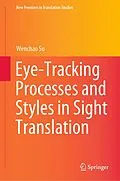This book presents new research on sight translation using cutting-edge eye-tracking technology. It covers various aspects of sight translation processes of both novice and professional interpreters, such as their textual processing behaviors, problem-solving patterns and reading-speech coordination. By focusing on the features of their gaze behaviors, the book describes the interpreters' processing behaviors and categorizes them into different processing styles. As one of the first books on sight translation employing an eye-tracking technique as the research method, it offers a valuable reference guide for future eye-tracking-based translation and interpreting research.
Autorentext
Wenchao Su is currently Yunshan Young Scholar at the School of Interpreting and Translation Studies, Guangdong University of Foreign Studies. An active researcher who uses eye-tracking technology to study interpreting processes, she has developed a keen interest in the cognitive and psycholinguistic investigation of interpreting processes and has published her research in leading translation studies journals.
Inhalt
AcknowledgementsList of Tables and Figures
List of Abbreviations
Chapter 1 Introduction
1.1 Research Purpose and Motivation
1.2 Research Background
1.3 Research Questions5
1.4 Significance of the Study
1.5 Structure of the Thesis
1.6 Summary
Chapter 2 Issues and Approaches to CTIS
2.1 Major Issues and Findings in CTIS2.2 Research Approaches to CTIS
2.3 Translation Styles in CTIS
2.4 Summary
Chapter 3 Translation Style in Sight Translation
3.1 Defining the Concept of Translation Style
3.2 Characteristics of Sight Translation
3.3 Global Behavioral Styles
3.3.1 Different Stages, Different Behaviors
3.3.2 Interaction Between Behaviors
3.3.3 Coordination Behavior
3.4 Local Behavioral Styles3.4.1 Problem Identification Behavior
3.4.2 Problem-solving Behavior
3.4.3 Problem Triggers and Coordination Behavior
3.5 Behavioral Styles Between Novices and Professionals
3.6 Summary
Chapter 4 Research Design
4.1 Indicators of Each Research Question
4.2 Data collection
4.2.1 Participants
4.2.2 Materials
4.2.3 Apparatus and Presentation of Stimuli
4.2.4 Procedure
4.3 Data Analysis
4.3.1 Eye Data Quality
4.3.2 General Guidelines for Conducting LMER Analysis
4.3.3 Data Analysis for Global Style 1
4.3.4 Data Analysis for Global Style 24.3.5 Data Analysis for Global Style 3
4.3.6 Data Analysis for Local Style 1
4.3.7 Data Analysis for Local Style 2
4.3.8 Data Analysis for Local Style 3
4.4 Summary
Chapter 5 Results
5.1 Global Style 1: Eye-Movement Behaviors as Reflected in Five Global Measures in the Two Stages
5.1.1 Overall Gaze Patterns
5.1.2 Task Time
5.1.3 Fixation Count
5.1.4 Saccadic Amplitude
5.1.5 Fixation Duration
5.1.6 Pupil Dilation
5.1.7 Summary
5.2 Global Style 2: Gaze Behavior in Actual Sight Translation as Affected by Gaze Behavior in Preparation
5.2.1 Effect of TT1 on TT2
5.2.2 Effect of FC1 on FC2
5.2.3 Effect of SA1 on SA2
5.2.4 Effect of FD1 on FD2
5.2.5 Effect of PD1 on PD2
5.2.6 Summary
5.3 Global Style 3: Coordination Behavior as Reflected via EVS
5.3.1 Max. EVS at Textual Level
5.3.2 Min. EVS at Textual Level
5.3.3 Summary
5.4 Local Style 1: Problem Identification Behavior
5.4.1 Classification, Location and Features of Potential Problems
5.4.2 Cognitive Load of Common Potential Problems5.4.3 Interaction Between Potential Problems and Group on Cognitive load
5.4.4 Summary
5.5 Local Style 2: Problem-solving Behavior
5.5.1 Types of Problem-solving Processes
5.5.2 Problem-solving Behavior as Indicated by Eye Measure
5.5.3 Problem-solving Behavior as Indicated by Eye Measure and Translation Output
5.5.4 Summary
5.6 Local Style 3: Coordination Behavior as Reflected via EVS and Translation Problems
5.6.1 Descriptive Statistics of EVS at Word Level
5.6.2 Problem Effect on Max. EVS5.6.3 Problem Effect on Min. EVS
5.6.4 Interaction Between Translation Problems and Group on EVS
5.6.5 Summary
5.7 Summary of the Chapter
Chapter 6 Discussion
6.1 Gaze Behavior in Preparation and in Actual Sight Translation
6.2 Impact of Gaze Behavior in Preparation on Gaze Behavior in Actual Sight Translation
6.3 Global Coordination Styles
6.4 Problem Identification Behavior
6.5 Problem-solving Behavior
6.6 Local Coordination Styles
...
